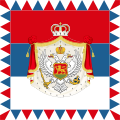Danilo I, Prince of Montenegro
| Danilo I | |||||
|---|---|---|---|---|---|
Prince-Bishop of Montenegro | |||||
| Reign | 1851–1852 | ||||
| Predecessor | Petar II | ||||
| Successor | Himself (as Prince), Nikanor Ivanović (as Bishop) | ||||
| Born | 25 May 1826 Njeguši, Montenegro | ||||
| Died | 13 August 1860 (aged 34) Kotor, Austrian Empire | ||||
| Burial | |||||
| Spouse |
Darinka Kvekić (m. 1855) | ||||
| Issue | Princess Olga | ||||
| |||||
| House | Petrović-Njegoš | ||||
| Father | Stanko Petrović-Njegoš | ||||
| Mother | Krstinja Vrbica | ||||
| Religion | Serbian Orthodoxy | ||||
| Seal |  | ||||



Danilo I Petrović-Njegoš (Serbian Cyrillic: Данило I Петровић-Његош; 25 May 1826 – 13 August 1860) was the ruling Prince of Montenegro from 1851 to 1860. The beginning of his reign marked the transition of Montenegro from a traditional theocratic form of government (Prince-Bishopric) into a secular Principality.[1]
He became involved in a war with the
Rise to power as Prince
When Petar II Petrović-Njegoš died, the Senate, under the influence of Đorđije Petrović (the wealthiest Montenegrin at the time), proclaimed Petar's elder brother Pero Tomov as Prince (not bishop, or Vladika). Nevertheless, in a brief struggle for power, Pero, who commanded the support of the Senate, lost to the much younger Danilo who had much more support among the people.
Prior to the determination of Petar's successor, after making peace between the
After centuries of theocratic rule, Danilo was the first Montenegrin secular prince who did not hold the ecclesiastical position of the Vladika. He was planning to upgrade the status of Montenegro turning it into a kingdom but did not live long enough to see his ambitions realized.
Military successes
It was during Danilo's reign that Montenegro won its most important battle with Turkey and its de facto independence. His charismatic elder brother, Grand Voivode Mirko Petrović-Njegoš led a 7,500 strong army and won the crucial Battle of Grahovac against the Turks (between 7,000 and 13,000) on 1 May 1858. The Turkish forces were routed. A considerable arsenal of war trophies was left in the Montenegrins hands, to come handy again in the final wars of independence in 1862 and 1875-1878.
This major victory had had even more diplomatic significance. The glory of Montenegrin weapons was soon immortalized in the songs and literature of all the South Slavs, in particular the Serbs in Vojvodina, then part of Austria-Hungary. Montenegrin victory forced the
Alliance with Russia and its failure
Danilo sought in Russia a military ally while trying not to upset Austria. His educated and wealthy wife together with Russia's failure to live up to promise for Montenegro's international recognition of full sovereignty, heavily influenced his Francophile attitude. This Francophile attitude was detrimental to Danilo's relations with Russia, Austria and Serbia, who saw the good relations between Montenegro and France as a threat to their interests.
At the same time, all major European powers worked to undermine Russian influence in

Danilo's enemies grew in numbers and included Danilo's elder brother, Grand Voivode Mirko and the president of the Senate Đorđije Petrović. The plans to organize the elimination of the Prince were coined by the Montenegrin emigration led by Stevan Perović Cuca and assisted by foreign powers. Danilo's loyals managed to assassinate Perović in Constantinople
Danilo's Code
In domestic issues, Danilo was an
Danilo used the Law of Petar I Petrović-Njegoš as an inspiration for his own General Law of the Land from 1855 (Zakonik Danila Prvog).[2] Danilo's Code was based on the Montenegrin traditions and customs and it is considered to be the first national constitution in Montenegrin history. It also stated rules, protected privacy and banned warring on the Austrian Coast (Bay of Kotor).
Danilo organized the first census in Montenegro in 1855 and ordered that all Montenegrin households be recorded. According to the census, Montenegro's population was 80,000.
Danilo established a tax plan, which was accepted by all tribes of Montenegro and the Hills except the
Personal life
After failed attempts of matching Danilo with Princess Kleopatra
Assassination and successor
Danilo was assassinated in August 1860, as he was boarding a ship at the port of
References
- ^ Ćirković 2004, p. 215.
- ^ Ćirković 2004, p. 216.
Sources
- ISBN 9781405142915.



